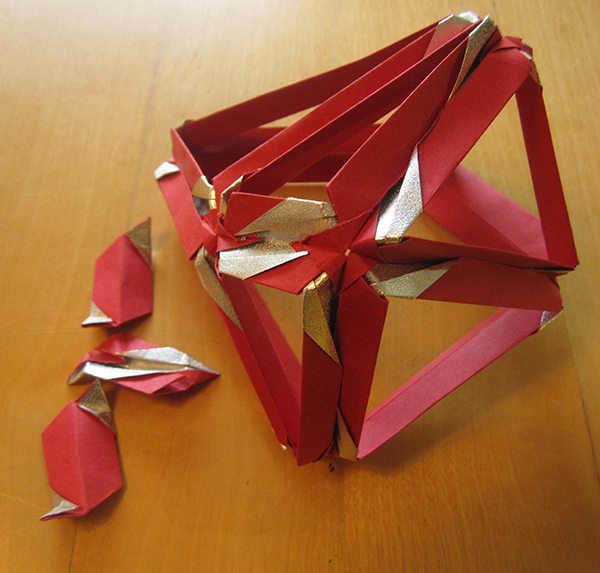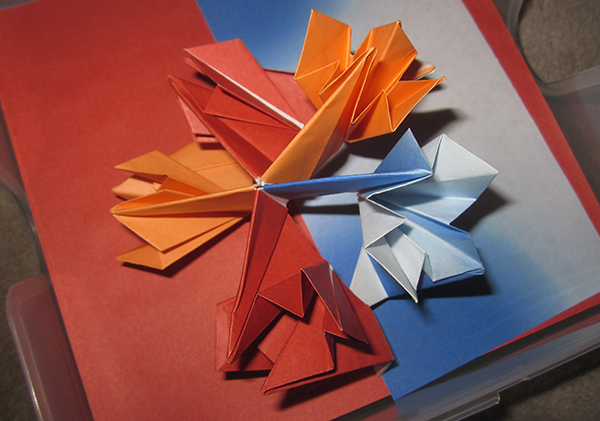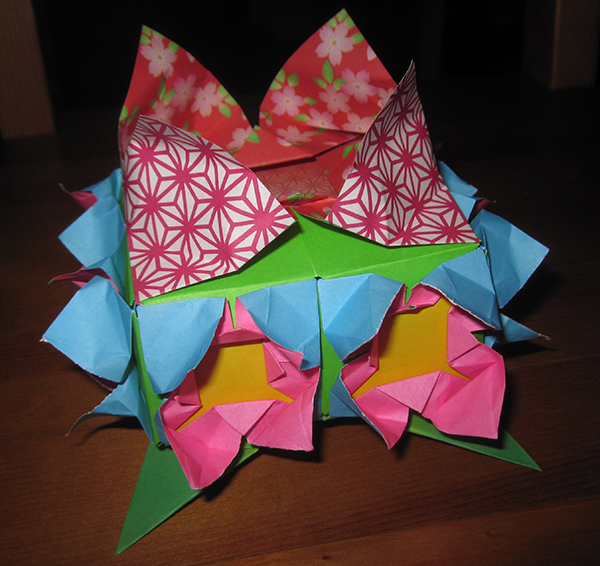Sometimes an origami model just doesn’t work out. Here’s a collection of some of my failures.

One thing I’m interested in doing is finding unusual polyhedra, and designing origami around them. This here was meant to be Steffen’s polyhedron, which is a flexible and concave polyhedron. “Flexible” means that it can be deformed even when each of the faces is rigid. “Concave” means that some of its edges are bent inwards instead of outwards. Cauchy’s Rigidity theorem states that convex polyhedra cannot be flexible, and Steffen’s polyhedron is an example of why it doesn’t also apply to concave polyhedra.
Anyway, this is tricky to design because I basically need to make a bunch of triangles of arbitrary sizes, and I need some way to attach them together. At some point, I got the bright idea of making triangle edges rather than triangles. And I didn’t even have to design my own edges, I just took the “Jade” units from Ekaterina Lukasheva, which are designed to be of arbitrary length. I carefully cut the paper to size (which required a bunch of oddly dimensioned rectangles, like 10:17), and started putting pieces together.
But it turns out, the design was fundamentally flawed. The geometry of the jade units doesn’t work out, and you just can’t put arbitrary triangles together with it. Well, back to the drawing board.

Here’s a failure using one-piece origami. I was interested in folding objects directly from crease patterns, and for my first attempt I tried folding Robert Lang’s Doe. This probably wasn’t a good choice for a first model, given that I had no idea what I was doing. Well, it’s not bad for a first try.

This was an attempt at Carnation Leroy by Carlos Cabrino. It’s a guest model in Origami Inspirations by Meenakshi Mukerji. Well, this one wasn’t my fault. The diagrams were awful. My units looked completely different at the end, and I couldn’t figure out how the pieces were supposed to fit together even in principle.

Okay, so this model isn’t really a failure. It’s an aesthetic failure, okay? I took Meenakshi Mukerji’s Flower Cube unit, and tried connecting larger units to smaller units. Design-wise, it was sturdy and solid. But what was I doing with the colors? It’s too busy and neon. I also think it looks like boxbot, ie terrible.

Sorry this comments is kind of late; I just discovered your blog (PZ said “origami,” which caught my eye).
I don’t think an origami version of Steffen’s Polyhedron would work very well, because (a) the range of motion is very small, and (b) in origami polyhedra, there’s always a little bit of shiftiness just from the compliance of the paper and joints. I recently made one from laser-scored wood veneer, which was stiff enough that it worked nicely; but I think with a paper one, it would be naturally a bit “mushy.”
Nevertheless, if you’d like to persist, I’d suggest looking into a Zig-Zag unit (like Neale’s Dodecahedron); by playing with the angles, you can get the desired different edge lengths, and could probably also achieve faces with no holes as well.
@bugfolder,
You wouldn’t remember, but we recently met! It was at a book signing, and I was wearing Bernie Peyton’s Shark Chapeau… I asked about tessellations.
I’ll look into the zig-zag units (and I think I actually have one of those dodecahedra lying around). I’m also interested in trying out the Szillassi polyhedron and Császár polyhedron if it’s successful. Those might be quite challenging though.